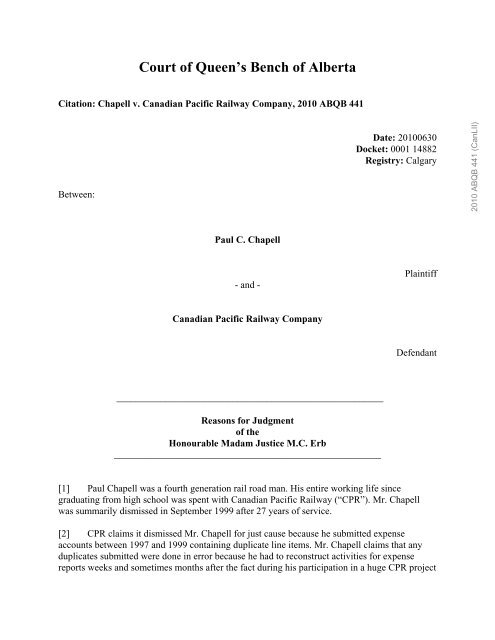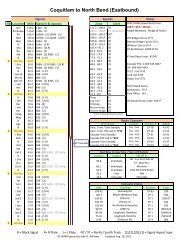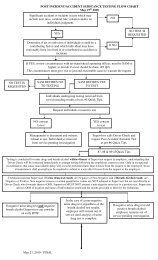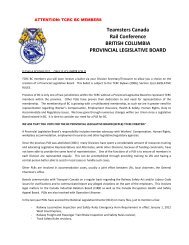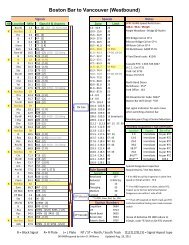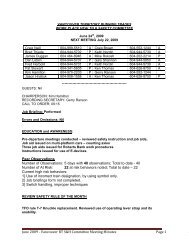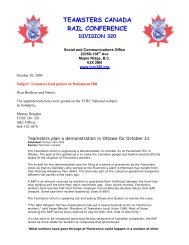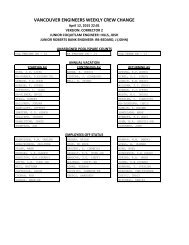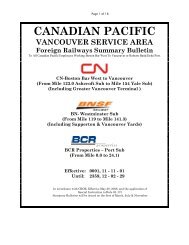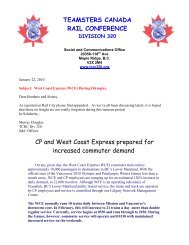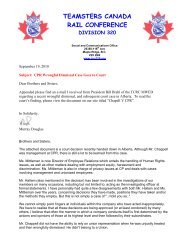Court of Queen's Bench of Alberta - TCRC 320
Court of Queen's Bench of Alberta - TCRC 320
Court of Queen's Bench of Alberta - TCRC 320
You also want an ePaper? Increase the reach of your titles
YUMPU automatically turns print PDFs into web optimized ePapers that Google loves.
<strong>Court</strong> <strong>of</strong> Queen’s <strong>Bench</strong> <strong>of</strong> <strong>Alberta</strong>Citation: Chapell v. Canadian Pacific Railway Company, 2010 ABQB 441Between:Date: 20100630Docket: 0001 14882Registry: Calgary2010 ABQB 441 (CanLII)Paul C. Chapell- and -PlaintiffCanadian Pacific Railway CompanyDefendant_______________________________________________________Reasons for Judgment<strong>of</strong> theHonourable Madam Justice M.C. Erb_______________________________________________________[1] Paul Chapell was a fourth generation rail road man. His entire working life sincegraduating from high school was spent with Canadian Pacific Railway (“CPR”). Mr. Chapellwas summarily dismissed in September 1999 after 27 years <strong>of</strong> service.[2] CPR claims it dismissed Mr. Chapell for just cause because he submitted expenseaccounts between 1997 and 1999 containing duplicate line items. Mr. Chapell claims that anyduplicates submitted were done in error because he had to reconstruct activities for expensereports weeks and sometimes months after the fact during his participation in a huge CPR project
Page: 2which put him “on the road” for nearly two years. He points to $2,800 in legitimate claimsidentified by CPR’s auditors which he did not submit, also in error, for the same reasons.Mr. Chapell brings this wrongful dismissal action claiming the allegations are unfounded andseeks pay in lieu <strong>of</strong> notice, compensatory damages, interest and costs. CPR seeks dismissal <strong>of</strong>the wrongful dismissal claim and recovery for the duplicate expenses paid to Mr. Chapell in itscounter claim.[3] The parties agree that the principal issue is whether Mr. Chapell was wrongfullydismissed, or dismissed for just cause; specifically, whether he intended to defraud his employer.CPR bears the onus <strong>of</strong> pro<strong>of</strong>. The secondary issue is what damages follow if Mr. Chapell waswrongfully dismissed. It is not disputed that Mr. Chapell was dismissed without notice or pay inlieu <strong>of</strong> notice.2010 ABQB 441 (CanLII)[4] For the reasons which follow, I find that Mr. Chapell was wrongfully dismissed. Inparticular, I find on the evidence presented during this 12-day trial, that Mr. Chapell did notintend to defraud the Defendant but, in fact, erroneously submitted duplicate expenses.[5] The background facts are largely not disputed. Those together with the facts proved bythe evidence before this <strong>Court</strong> comprise the background narrative.Background[6] In June 1972, after graduating from highschool, the Plaintiff took a job with CPR as ayard man in the Toronto terminal. In doing so he had embarked on the career path <strong>of</strong> hisforebears over the course <strong>of</strong> four generations along with siblings and cousins. Although hestarted out in a labour job around the yards, he was promoted to yard foreman within his first sixmonths and put in charge <strong>of</strong> the yard crew responsible for switching freight cars and trains onrail tracks. He was eighteen years old at the time. Over the next several years, Mr. Chapellcontinued on a consistently upwardly mobile track moving out <strong>of</strong> the union ranks intomanagement. CPR assigned him senior positions at numerous terminals in southwestern Ontario.[7] By 1996, he was the assistant superintendent <strong>of</strong> the Toronto yard, the largest in thecountry, involving some 72 rail lines connecting a network <strong>of</strong> centres from coast-to-coast. Bythis time he had become recognized as an expert in the key yards and terminals area. He hadworked his way through all <strong>of</strong> the jobs leading up to his own and by doing so knew thechallenges <strong>of</strong> them all first hand. One <strong>of</strong> Mr. Chapell’s key responsibilities and one he excelledat was resolving congestion problems in the yards involving dozens <strong>of</strong> trains coming from alldirections. He did this routinely through prioritizing the movement <strong>of</strong> train cars and assistingthose under his supervision about which trains to run where and why. His role with CPR was animportant one and he conscientiously carried it out throughout his entire time with the railroad.[8] Because <strong>of</strong> his proven abilities in yards and terminals, Mr. Chapell was asked to join ateam based in Calgary to assist terminals across the country with achieving greater efficiencies.The focus was on rail traffic flow and congestion challenges. The project was called “Service
Page: 3Excellence.” CPR <strong>of</strong>ficials had great expectations. In particular, they hoped to improvepr<strong>of</strong>itability in the yards and terminals division by upgrading train turn-around time across thecountry so revenues would increase.On the Road with Service Excellence[9] After being assigned to Service Excellence in Calgary, Mr. Chapell who had spent somemonths living out <strong>of</strong> hotels and eating in restaurants, moved from Toronto to Calgary with hisfamily in July 1997.[10] Because <strong>of</strong> his expertise, Mr. Chapell, as team leader <strong>of</strong> the yards and terminals segment<strong>of</strong> Service Excellence, was required to design a series <strong>of</strong> workshops to be presented at numerouslocations across the country commencing with Moose Jaw, Saskatchewan.2010 ABQB 441 (CanLII)[11] Mr. Chapell designed a prototype workshop and then incorporated specific features toaddress local requirements. To do this, he conducted preparatory meetings with senior people ateach field location during which the plan for the workshops was configured. There were advancepresentations or “roll-outs” so senior managers in each location could see what was being<strong>of</strong>fered and could then select from their staff who should attend. Mr. Chapell conducted eachwork-shop himself and supervised the analysis and computer input <strong>of</strong> data acquired during thosepresentations which had to be done once the workshops were concluded for the day. Included inthe team members were data input personnel. The data created materials which had to be edited,printed and organized in binders to be left with the workshop participants for ongoing referencepurposes. The materials were critical to the process. They served as the reference guides for thenew approach. The materials differed at each location and had to be tailored to the needs <strong>of</strong> thedifferent yards and problem solutions identified in the workshops.[12] The data input and binder assembly was carried out in the evenings after the workshopsconcluded for the day. I accept Mr. Chapell’s evidence at trial that because the local print shopsproduced inadequate workshop materials, he acquired three portable photocopy machines andreproduced the material on site himself. He took a hands-on approach by personally assemblingwith other team members, up to 40 workshop binders a night. I accept Mr. Chapell’s evidencethat although the workload increased by doing the copying and assembly on site, the product wassuperior and something the team could be proud to leave with the workers at each location. Thecost saving to CPR was up to $80,000 at each location. Mr. Chapell’s measures were geared toincreasing quality and bringing down costs. As CPR personnel confirmed at trial, Mr. Chapell’ssegment <strong>of</strong> Service Excellence came in under budget at the end <strong>of</strong> the project. There is nodispute between the parties that the Service Excellence program was a substantial success andsaved CPR in excess <strong>of</strong> $53 million.[13] While the program was ongoing, Mr. Chapell received regular kudos for his role as wellas pay increases and bonuses along the same lines as he had in his earlier assignments.
Page: 4[14] In particular, Paul Bell, CPR’s Vice President, Transportation, testified at trial that Mr.Chapell was an “up and coming, well respected, very knowledgeable employee” who was also“very receptive to new innovations”. Mr. Bell attended the first workshop in Moose Jaw, sawMr. Chapell in action and described his work as “very effective”. Mr. Bell confirmed that it wasMr. Chapell’s responsibility to run the workshops, get the information needed, get input, getparticipants to commit to the program, create and deliver reference materials before leaving thefield location and facilitate implementation. He also confirmed that Mr. Chapell “did well” onthe project and his segment had come in under budget. Mr. Chapell’s supervisor for the latterpart <strong>of</strong> the project, Rick Evans, confirmed that Mr. Chapell’s performance was “excellent,” thathe was effective in the field particularly so at getting the locals engaged in the project. The onlyreports he received about his project work were “positive.”[15] In addition to the project’s tasks which Mr. Chapell considered his primary responsibilityand priority, he had to handle the administration <strong>of</strong> the program which involved tracking andsubmitting his own as well as the team’s expenses. Mr. Chapell’s segment <strong>of</strong> the ServiceExcellent project was the only one in which expenses were not billed directly to CPR.2010 ABQB 441 (CanLII)[16] Mr. Chapell testified that when the project started: “We [the project team] thought thelocal managers would be picking up those costs” but because <strong>of</strong> “bickering about who was topay what on whose budget,” Mr. Chapell covered the costs under his project’s responsibilities.This required tracking all project expenses both large and small.[17] Throughout the project, Mr. Chapell worked long hours at many centres betweenChilliwack, British Columbia and Montreal, Quebec several points across the three Prairieprovinces, Minnesota and many locations in Ontario. He was on the road most week days otherthan ordinary holiday weeks over about a two-year period.[18] At the commencement <strong>of</strong> the project, four workshops were to be conducted at eachlocation across the country. Because the project was an immediate success, CPR executivesincreased the number <strong>of</strong> workshops to as many as 10 or 12 at each location. Despite the obvioussubstantial increase in the workload tripling the workshops would cause, CPR did not provideany logistical or administrative support.[19] Mr. Chapell readily admitted at trial that the administrative and accounting tasks were achallenge for him from the start. Once on the road, the task became much larger. He testified,and I accept his evidence, that he asked CPR personnel for a separate corporate credit card so hecould at least separate his personal expenses from those <strong>of</strong> the team. This was refused. He askedfor secretarial services to be added to the road team. It was not provided. Mr. Chapell testifiedthat when he raised the issue <strong>of</strong> receiving some administrative support his supervisor told him“don’t sweat the small stuff”.[20] For the run <strong>of</strong> the project, Mr. Chapell submitted 2,200 line items in expense claimsinvolving more than $200,000 in personal and team expenses. CPR at the beginning <strong>of</strong> theproject required expenses to be inputted on its “Lotus Notes” data entry system. Mr. Chapell
Page: 5discovered later on that the program was flawed in that when a correction was made, the systemdid not automatically replace or delete the corrected item. It just added another line entry withthe corrected information.[21] Early in, Mr. Chapell realized that purchasing individual trip tickets was creating a hugeexpense. So he worked out a method <strong>of</strong> booking airline tickets a month at a time utilizing a“reverse booking” or beginning an end <strong>of</strong> month ticketing approach permitted by the airline.These were booked for the whole team involving up to ten or twelve individuals and involvedelectronic ticketing. This became a major issue during the Air Canada strike when flights had tobe cancelled and rearranged for numerous people.[22] Although the system saved CPR thousands <strong>of</strong> dollars every month, the “E-tickets”accommodating changes in venue and schedules, reversing out fares, re-booking times whichmeant the dates booked to travel and the tickets billed did not always correspond to days actuallytravelled. Although Mr. Chapell had someone assisting him in the Calgary <strong>of</strong>fice with the flightbookings, he still had to be personally involved.2010 ABQB 441 (CanLII)[23] In addition to the project work, Mr. Chapell was called upon to help during the ice stormin southern Quebec in January 1998. CPR executives confirmed that Mr. Chapell and anotheremployee also experienced in yards and terminals were pulled from the Service Excellenceproject and assigned to the Montreal train terminal to unravel the massive piling up <strong>of</strong> trains. Thetwo worked 16 hours a day straight for days and immediately following the resolution <strong>of</strong> the logjam <strong>of</strong> trains, were sent back to pick up where they had left <strong>of</strong>f on Service Excellence without abreak. They did this without complaint.[24] Mr. Chapell found himself in a dilemma, many responsibilities and little time foradministrative tasks such as rendering expense accounts. Others observed his challenges.[25] Daniel Kelly <strong>of</strong> Pittsburgh, Pennsylvania, the most independent witness who testified inthe proceedings, was a consultant hired by CPR for the Service Excellence project. He spent agreat deal <strong>of</strong> time on the road with Mr. Chapell. His evidence was uncontroverted and I accept itin its entirety. Mr. Kelly joined the team in the spring <strong>of</strong> 1998 after the planning and design stagehad concluded. He remained with Service Excellence until the project concluded in June 1999.[26] Mr. Kelly’s evidence was that he met with Mr. Chapell each day starting at breakfast at6:30 a.m. Mr. Chapell had the design templates prepared and conducted the workshops at eachlocation. The workshops and follow-up were the focus <strong>of</strong> the project. They arrived at a locationthe day before, set up and did preparatory work. The two spent most days working together. Hesaw Mr. Chapell leading the workshops. Mr. Kelly said Mr. Chapell had accountability for thesuccess <strong>of</strong> the workshops and was the decision maker on what took place. He had the contentexpertise and led that initiative. Mr. Kelly said Mr. Chapell’s knowledge on the subject area was“vast.” He noted that Mr. Chapell focussed on content and Mr. Kelly focussed on process.
Page: 6[27] Mr. Kelly confirmed that he and Mr. Chapell had discussed his challenges with theaccounting problem and its complexity including the fact Mr. Chapell had wanted a corporatecredit card to separate expenses and bills sent to Service Excellence in Calgary so he would nothave the burden <strong>of</strong> handling them. There was not enough time in the day to get them done whilethe information was fresh in his mind. Mr. Kelly testified that these problems were no secretbecause <strong>of</strong> the sheer volume.[28] Mr. Kelly also testified that Mr. Chapell appeared to get increasingly disorganized astime went on and he had receipts everywhere. At trial Mr. Kelly testified:He had a lot on his plate. He was disorganized on his administrative duties. He’dlay receipts out trying to reconcile them, he had no administrative person helpinghim and was overwhelmed. He would be trying to figure it all out after severalweeks. I just saw that he was overwhelmed and disorganized. Most pr<strong>of</strong>essionalshave systems, Paul had no system, he was pulling receipts out <strong>of</strong> his pockets. Thehotel stays included younger staff so Paul was tracking rooms and meals forseveral guys who were sent on the project with no credit cards. It was quite amess for him. In a project like that the leader has accountability and the leaderusually has assistance. He tried to do it all himself, did not delegate these things. Iadvised him to delegate.2010 ABQB 441 (CanLII)[29] Mr. Kelly’s evidence was supported by the read-in evidence <strong>of</strong> Calvin Butterworth andJames Wakelin, two young members <strong>of</strong> the team, who travelled with Mr. Chapell. Mr.Butterworth said there were “lots <strong>of</strong> expenses” and he had observed Mr. Chapell working onexpenses during the project. Mr. Chapell told him it was very confusing because there were billscoming in long after the team had left a location. His signature was on hotel files and items werebilled to it that were not part <strong>of</strong> his project. These had to be tracked down and the hotel had to bedealt with to back them <strong>of</strong>f his credit card. The problems started around the middle <strong>of</strong> the projectand “continued to be arduous”. Mr. Wakelin heard Mr. Chapell asking his supervisor for helpbecause there was too much to do and not enough time.[30] Although the turn-around-time for reimbursement from CPR’s end was always timely,the challenge for Mr. Chapell was the input in the computer system in the manner CPR required.For example, when the hotel bills were submitted, the line items on the bill had to be brokendown and submitted under CPR’s format with designated line items for budgetary purposes. Attimes the hotels lumped items in a single category labelled “banquet” which in fact covered suchthings as some meals for the team members, use <strong>of</strong> meeting rooms separate from personal userooms, seminar equipment rentals and the like.[31] Mr. Chapell was responsible for reconstructing what the statements should properlyinclude for his program as well as identifying what the receipts he collected were for long afterthe fact. These included meals outside the hotels, who was present, which were for team events,vehicle rentals, meeting rooms, audio visual equipment, tables and chairs, groups’ meals,parking, supplies <strong>of</strong> paper, print cartridges, binders, pens, pencils and supplies.
Page: 7[32] The hotels had Mr. Chapell’s credit card signature on file so other CPR projects were, inerror, billed to it and he had to track them down and get them reversed out. Other people weresigning for things when he was not present. He stated at trial: “We got billed for stuff not agreedto by us which I had to renegotiate”. Mr. Chapell’s account was billed for meeting rooms notused and hotel meals not taken as the hotel required those to be guaranteed in advance by creditcard. Additional hotel bills would be sent sometimes weeks later after the team had left thelocation which Mr. Chapell had to find time to follow up on and figure out what they were forand whether they were even appropriate to his project. There were problems with the sheervolume <strong>of</strong> receipts which he just collected with a plan to sort it all out when he found time,lacking supporting documents and trying to figure out which expense month it related toincluding those missed which went on the next claim. There were problems reconstructing andvalidating receipts.2010 ABQB 441 (CanLII)[33] One <strong>of</strong> the areas questioned by CPR’s auditor after the fact was the billing for hotelrooms on weekends and times when the team was not in the location. Mr. Chapell explained thathe had negotiated a lower flat rate for a room to store the equipment in on weekends so that it alldid not have to be hauled back and forth during the projects duration.[34] There were meeting rooms on the hotel bills which were not for Mr. Chapell’s group.Charges followed the team after they left town. Mr. Chapell gave the example <strong>of</strong> the problemswith the billing by the Lombard Hotel in Winnipeg which took six or more months to clear up.He testified, and I accept his evidence, that <strong>of</strong> $2,500 in charges the hotel entered on his account,$1,130 <strong>of</strong> them were proper.[35] Mr. Chapell was simply picking up every receipt including restaurant table receipts,keeping the credit card receipts, trying to track those he thought were missing and taking, what Ifind to be, a shoe box stash approach. This created an enormous task <strong>of</strong> reconstruction, inparticular with transaction dates and receipts not corresponding with each other, all <strong>of</strong> whichmade reconciliation difficult.[36] When he did get the reports figured out to his satisfaction, he had trouble printing them.The printer would stop or skip, and he had to do the reports in segments.[37] Mr. Chapell testified that by the end <strong>of</strong> the project in late May 1999, he was exhaustedmentally and physically. By the time the project was winding up in June, he was still far behindin submitting his expenses, and still struggling to sort out problems with hotel billings, andreconciling receipts.[38] In early 1999, CPR moved to a new computer system called SAP. Mr. Chapell knew thatthis program could detect any duplicates on expense reports and during the latter months <strong>of</strong> theproject, also the period when the bulk <strong>of</strong> the errors were made, he took false comfort in his beliefthat if he made mistakes, SAP would flag them in the system.
Page: 8[39] When the program wound up in late May, Mr. Chapell was in a CPR boardroom trying toreconcile his last expense reports for the project. He said he had receipts lined up around a tabletrying to figure it out. There was pressure to get them out before the group went on summerholiday. Mr. Chapell recalls his then supervisor, Mr. Evans entering the room. “I [Mr. Chapell]told him that all <strong>of</strong> this was ridiculous, he just left”. Mr. Chapell said that in the end hecompleted the expense reports satisfied that he had it to the best level <strong>of</strong> accuracy he couldachieve.[40] After the project ended, Service Excellence was dismantled and participants were toreturn to their previous departments. Mr. Chapell was to continue his work in yards andterminals. There was some indication that CPR was facing problems re-integrating all <strong>of</strong> theemployees.Detection <strong>of</strong> the Irregularities2010 ABQB 441 (CanLII)[41] On June 17, 2009, CPR’s internal auditor, Nick Roberts, in Montreal, detected sixirregularities on Mr. Chapell’s May and June expense reports. Mr. Roberts reported this to Mr.Bell and Pat Pender, Vice President, Field Operations. He was directed to audit the expensereports for the whole Service Excellence project. Mr. Bell confirmed that he referred the matterto others for follow up. Mr. Roberts confirmed that the irregularities were largely in the reportsfor the latter stages <strong>of</strong> the project. Many expense reports were coming in after January 1999.There was one minor potential expense error in 1997.[42] Mr. Roberts conducted the audit which flagged not only 37 line items as irregularitiesrequiring clarification valued at approximately $9,000, but also detected errors against Mr.Chapell’s own interest. This was reflected in his failing to submit for reimbursement a total <strong>of</strong>$2,871.22 legitimate expenses.[43] Mr. Evans testified that he first heard about the issue when he was contacted by theAccounting Department in Montreal . He was told that there were six irregularities detected inMr. Chapell’s expense reports. He contacted Mr. Chapell and asked him to recheck his records.Mr. Chapell checked them and reported back that he had found three more in the same report.The Investigation[44] After Mr. Bell and Mr. Pender were apprised <strong>of</strong> the irregularities and ordered the largeraudit, the matter was turned over to the CPR’s Director <strong>of</strong> Human Resources, Barbara Mittlemanon June 19, 1999. Mr. Bell directed that she conduct a “clarification meeting” with Mr. Chapell.This took place on August 4, 1999. One <strong>of</strong> Ms. Mittleman’s subordinates, Mike Mayhew, was toattend.[45] Prior to the clarification meeting a number <strong>of</strong> internal meetings took place. Ms.Mittleman met with the auditor on July 20, 1999. She was in contact with CPR police which wasapparently gathering information for the Crown Prosecutor’s <strong>of</strong>fice.
Page: 9[46] In preparation for the August 4th meeting, Ms. Mittleman arranged to have a CPR police<strong>of</strong>ficer seated outside the interview room in case there were “any problems”. She testified thatthis was because Mr. Chapell had an <strong>of</strong>f-site altercation in 1997 with another male employeefollowing which he agreed to participate in an alcohol abuse program. His response was selfimposedsobriety.[47] Ms. Mittleman also spoke with Mr. Chapell’s former supervisor, Mr. Waver, who wasnot called to testify. Her notes from that meeting focus on Mr. Chapell’s past conduct, whetherhe had returned to alcohol consumption (he had not); speculation about his financial situationincluding his obligations to his former spouse and children and the fact he always made hispayments. Ms. Mittleman attempted to acquire confidential information about Mr. Chapell fromCPR’s Employee Assistance program but was denied access. Meantime CPR police attended atthe <strong>of</strong>fices <strong>of</strong> Park N’ Fly to check out a receipt. Ms. Mittleman contacted the Holiday Inn abouta duplicate receipt.2010 ABQB 441 (CanLII)[48] Ms. Mittleman conducted the clarification interview with Mr. Chapell. She testified thatthe meeting was for clarification purposes as part <strong>of</strong> the investigative process. She said she madeefforts to be fair. However, she provided him with no advance notice that there were 37irregularities, out <strong>of</strong> the approximately 2,200 line items submitted over the course <strong>of</strong> the project.She acknowledged that when Mr. Chapell attended the meeting he was expecting to address thenine discrepancies he had discussed with Mr. Evans, three <strong>of</strong> which he had brought forwardhimself.[49] Questioned in cross-examination at trial, Ms. Mittleman stated that Mr. Chapell was notgiven the full information about what was to be discussed on August 4, because she did not wanthim to “destroy documents” or “fabricate an explanation.” She defended this position whileconceding the fact that CPR already had all <strong>of</strong> the documents. She further stated that failing toshare the actual nature <strong>of</strong> the meeting would ensure she got more “truthfulness” in his responses.At the same time, Ms. Mittleman told the <strong>Court</strong> that she was ensuring that Mr. Chapell wasbeing treated fairly.[50] Although she initially denied in cross-examination that she was working with CPR policeand sharing information, her own notes and correspondence from the police state: “It will beimportant to discuss your findings with our investigating <strong>of</strong>ficer as soon as possible after theconclusion <strong>of</strong> your interview [August 4] to assist us in the continuation <strong>of</strong> our investigation”.Ms. Mittleman conceded in cross-examination that she shared her notes with CPR police.Notably, no criminal proceedings were ever commenced against Mr. Chapell with respect to theirregularities alleged.[51] Ms. Mittleman acknowledged that Mr. Chapell had told her that he had spent five days inJune 1999 trying to put the receipts in order, his frustration over the process, his scramble to findreceipts, his state <strong>of</strong> exhaustion and his belief that SAP would catch any errors. He was puttingin long hours on the job and he stated that he did not knowingly put in duplicates. She was alsoaware that it had been difficult for him to recall what items were for and that once the expense
Page: 10submission was completed there was no time to recheck his entries. Hotels were sending bills fordates when the team was not staying there. Some <strong>of</strong> the team members who were handling theirown expenses had their charges billed to his credit card without realizing it.[52] Ms. Mittleman conceded in cross examination that from the beginning <strong>of</strong> the project,CPR and herself in particular were aware that Mr. Chapell would have a “tough time doingaccounting” on the project and that electronic ticketing would be “tough to keep track <strong>of</strong>”. It waswell known that Mr. Chapell was handling the administrative tasks for the whole team. Thisinformation was reconfirmed in her discussion with Mr. Chapell’s original supervisor on theproject, Tom Waver.[53] Ms. Mittleman also confirmed that prior to meeting with Mr. Chapell, she had tried toaccess confidential information from the Employee Assistance Program which Mr. Chapell hadparticipated in arising from an altercation with another employee which was alcohol related. Herrequest was refused. She also acknowledged that she tried to acquire information about Mr.Chapell’s personal finances prior to the meeting.2010 ABQB 441 (CanLII)[54] All <strong>of</strong> the CPR witnesses including Ms. Mittleman stated that they had no interest in thecontext <strong>of</strong> Mr. Chapell’s project or what was going on at the time. They were interested only inthe fact that duplicates were detected and the assumption <strong>of</strong> fraud was concluded from that andlittle else. They did not interview other members <strong>of</strong> the Service Excellence team to confirm Mr.Chapell’s statements about the problems he was having. They also repeatedly took the positionthat because Mr. Chapell appeared to be organized at the August 4, 1999 meeting and broughtcopies <strong>of</strong> what he had submitted, more than two months after the project ended, they dismissedany suggestion that he had been disorganized during the project when it came to his expensevalidation and submission.[55] After the clarification meeting, Ms. Mittleman asked one <strong>of</strong> her subordinates, MichaelHallam to review her report, notes and recommendation to dismiss Mr. Chapell. Mr. Hallamtestified that he did so and advised that he did not believe it supported a finding that Mr. Chapellintentionally made the errors in his reports. Further, following the August 4 meeting, Mr.Chapell submitted a letter to CPR trying to better respond to the questions raised at the meeting.[56] Because <strong>of</strong> this, another interview with Mr. Chapell was set for August 30, 1999. At thatmeeting Mr. Hallam questioned Mr. Chapell. Mr. Mayhew was also present. An example <strong>of</strong> onearea <strong>of</strong> questioning is this:Q: If you were able to handle all the complex tasks associated with your jobthat you mention in your letter, why were you having so many problemskeeping track <strong>of</strong> which expenses you had submitted and which ones youhad not?A: The workshops got the priority, not the expense accounts.
Page: 11[57] A recurrent theme throughout Mr. Chapell’s response to questions was that he wasoverwhelmed with the project work and had little time to deal with his expenses. His attempts toexplain the context in which he was doing the reports were interpreted as evasiveness. Mr.Hallam testified that he spoke with some <strong>of</strong> the team members in Calgary about Mr. Chapell’sexpense accounts but did not speak to anyone who had been in the field with him.[58] Following that meeting, Mr. Hallam and Mr. Mayhew concurred with Ms. Mittleman’sconclusion that Mr. Chapell should be dismissed. CPR dismissed him citing cause, onSeptember 9, 1999.Credibility <strong>of</strong> Witnesses[59] Mr. Chapell’s evidence was straightforward and substantially consistent throughout fromthe time the issue was raised 11 years ago, through his examinations for discovery and hisevidence at trial. His evidence in many respects dovetails with that <strong>of</strong> other witnesses,particularly that <strong>of</strong> Mr. Kelly, the consultant hired by CPR, who worked closely with him duringthe relevant period. Mr. Kelly was also one <strong>of</strong> the few witnesses other than Mr. Chapell who hada good, independent recollection <strong>of</strong> the important points. I accept the evidence <strong>of</strong> both thesewitnesses as credible and reliable.2010 ABQB 441 (CanLII)[60] The Defence attempted to paint Mr. Chapell as dishonest and lacking credibility. ThePlaintiff took issue with this approach arguing that the rule in Browne v. Dunn (1893) 6.R.67(H.L.) was breached in particular because the matters argued were not put to Mr. Chapell incross examination. Because <strong>of</strong> my finding with respect to Mr. Chapell’s evidence, I see noreason to address this specific issue.[61] The Defence witnesses were all CPR employees or former employees and largelyaddressed the events leading up to the detection <strong>of</strong> the duplicates and Mr. Chapell’s dismissal.Most <strong>of</strong> the CPR witnesses had no independent recollection <strong>of</strong> the events and had prepared fortrial by referring to each others notes as well as those made by themselves at the time. In anyevent, much <strong>of</strong> what those witnesses had to say simply tracked the undisputed events leading upto the investigation into the irregularities. In addition, the evidence <strong>of</strong> CPR’s auditor wasbalanced and disclosed information which favoured both CPR and Mr. Chapell.[62] The evidence <strong>of</strong> others was less reliable. For example, Mr. Hallam’s recollection <strong>of</strong>events conflicted with the evidence he gave at examinations for discovery. He testified that themeeting on August 30 with Mr. Chapell took between two and three hours. At examinations fordiscovery, conducted seven years ago, he testified that it started at 9 a.m. and continued until 3p.m. His notes which are somewhat abbreviated, did not record matters raised by Mr. Chapellsuch as his declaration that his expense reports containing duplicates were not submittedintentionally. Mr. Hallam had no recollection that this declaration was made but had noexplanation as to why he would not have asked the question. I do not accept Mr. Hallam’sevidence on that point.
Page: 12[63] The least objective defence evidence was from Ms. Mittleman. I find that herinvestigation was not the fact-finding mission she indicated it was, but rather an exercise in casebuilding against Mr. Chapell. In both her report and in notes from meetings with other CPRpersonnel, Ms. Mittleman attempted to diminish Mr. Chapell’s role in Service Excellencecontrary to that <strong>of</strong> CPR’s own executive people. She suggested Mr. Chapell was just “runningsome workshops in different places involving putting up some brown paper and havingemployees put stickies on it and recording the information”. Ms. Mittleman’s understanding wasthat after the workshops, Mr. Chapell only had to ensure the data processing people inputted theinformation in the evening.[64] Other than her discussion with Mr. Waver she did not speak with any member <strong>of</strong> Mr.Chapell’s team about the work load that was repeatedly referenced.2010 ABQB 441 (CanLII)[65] After the “clarification meeting” Ms. Mittleman was well aware that Mr. Chapell wasrunning many workshops a week and putting together at least 40 manuals at each site to be leftwith the participants. She knew the team was flying back and forth Monday’s and Friday’s andthat he had found the administrative side a “massive” undertaking given all <strong>of</strong> his otherresponsibilities. Yet she elected to check nothing.[66] Despite available information to the contrary from others as well as Mr. Chapell that hewas disorganized and had a lot on his plate, Ms. Mittleman, concluded this could not be truebecause he arrived at the meetings with copies <strong>of</strong> his reports and a Day Timer. This conclusionmust be considered in the context <strong>of</strong> the fact that the first meeting took place at least two monthsafter the project concluded and after Mr. Chapell had some vacation time.[67] Ms. Mittleman’s testimony at trial indicates that she was dismissive <strong>of</strong> any explanationthat Mr. Chapell <strong>of</strong>fered. I find that she was not prepared to consider any context at all or the factthat the discrepancies in the overall context <strong>of</strong> the Service Excellence program was a massiveundertaking. Furthermore, the failure <strong>of</strong> CPR to provide administrative and logistical supportwhen it clearly should have done so for prudent management if nothing else, suggests to this<strong>Court</strong> that the investigation she headed was clearly case building. Her claim that she was tryingto ensure fairness to Mr. Chapell is certainly not the case as indicated by the steps she took toacquire Mr. Chapell’s personal information when as a lawyer she well knew or should haveknown the complete inappropriateness <strong>of</strong> it.[68] Further, during her testimony she attempted repeatedly to qualify her answers prior togiving them and had a dismissive demeanour throughout. I find that her testimony demonstrateda lack <strong>of</strong> objectivity in the task she was asked to carry out. During the investigation she failed togather sufficient information about the full nature <strong>of</strong> his position and, in particular, hisadministrative duties. This could easily have been accomplished had she spoken to anyone whohad worked in the field with Mr. Chapell, particularly, Mr. Kelly, CPR’s outside consultant.[69] Further, at no time did CPR explore why an employee intent on defrauding his employerwould fail to claim $2,800 worth <strong>of</strong> legitimate expenses to which he would have been ordinarily
Page: 13entitled or would have responded to a question about six irregularities by pointing out threemore. If someone was intent on committing fraud, why were there so many duplicates withinlines <strong>of</strong> each other on the same page and others back to back line items. Some were <strong>of</strong> such smallamounts as to be described as loose change.[70] It is also interesting to note that in its haste to consider the irregularities in the expensereports that shorted CPR, there is no evidence that the company ever considered the irregularitieswhich shorted Mr. Chapell, both for the same reasons. Failing to consider the total picture andturning a blind eye to any kind <strong>of</strong> context or surrounding circumstances was unfair to say theleast.Proving Just Cause for Dismissal2010 ABQB 441 (CanLII)[71] The Supreme <strong>Court</strong> <strong>of</strong> Canada in McKinley v. BC Tel, [2001] 2 S.C.R. 161 establishedthat the standard to be applied in wrongful dismissal cases where fraudulent or deceitful conductis alleged is pro<strong>of</strong> on a balance <strong>of</strong> probabilities. Where deceit is identified, there follows anassessment whether the nature and degree <strong>of</strong> dishonesty warranted dismissal.[72] The balance <strong>of</strong> probabilities test was recently described by the Supreme <strong>Court</strong> <strong>of</strong> Canadain F. H. v. MacDougall, [2008] 3 S.C.R. 41 at para. 49: “In all civil cases, the trial judge mustscrutinize the relevant evidence with care to determine whether it is more likely than not that analleged event occurred” (per Rothstein J.) At paragraph 46, the learned justice also defined thequality <strong>of</strong> the evidence required – clear, cogent and convincing.[73] To prove fraud, there must be demonstrated to have been dishonesty or fraudulent intent.This entails an element <strong>of</strong> intention. In <strong>Alberta</strong>, employees have been found to have beenwrongfully dismissed where the employer could not prove dishonesty or fraudulent intent: Toddv. 7-Eleven Canada Inc., 2004 ABQB 86, para. 26.[74] The only intention attributable to Mr. Chapell established in these proceedings wasgetting the job done which he did do in an exemplary fashion. He was sloppy and disorganizedparticularly in the latter stages <strong>of</strong> the project. By then, to use the vernacular, he was running onempty.[75] I find that CPR has failed to satisfy this <strong>Court</strong> that Mr. Chapell intended to defraud it.There is no evidence which I accept that suggests such a thing. Some <strong>of</strong> the amounts claimed asduplicates can be described as loose change. Some were not confirmed as duplicates at all. Manywere on the same page, clearly errors by someone not paying close attention.[76] I find on a consideration <strong>of</strong> the totality <strong>of</strong> the evidence that the Plaintiff cannot be said tohave been deceitful or had an intention to defraud his employer. I base this on a consideration <strong>of</strong>the totality <strong>of</strong> the evidence including the clear and uncontroverted evidence <strong>of</strong> Mr Chapell’s state<strong>of</strong> disorganization in a heavily encumbered work environment.
Page: 14[77] There is no evidence that Mr. Chapell had the background for this level <strong>of</strong> logistical andadministrative tasking and CPR was well aware <strong>of</strong> that. For reasons never explained, his segmentwas the only one in which expenses were not billed directly to CPR. Mr. Chapell was clearlyselected to lead a segment <strong>of</strong> the Service Excellence project because <strong>of</strong> his yards and terminalsexpertise not his administrative skills.[78] In addition to all <strong>of</strong> the evidence presented in this trial, it is clear that Mr. Chapell infocussing on the secondary task, keeping detailed and careful records <strong>of</strong> expenses for himself,the project itself and numerous other individuals, simply got away from him. He becamedisorganized and in trying to reconstruct events and, not surprisingly, made errors.[79] Further, while the sloppiness <strong>of</strong> the expense reports are evident, CPR had other optionsthan dismissal for cause.2010 ABQB 441 (CanLII)[80] Mr. Chapell was wrongfully dismissed from his employment with the Defendant CPRand is entitled to his damages arising there from.Damages in Lieu <strong>of</strong> Notice[81] The Plaintiff seeks damages in lieu <strong>of</strong> notice <strong>of</strong> termination. The quantum <strong>of</strong> damagesrequires an assessment <strong>of</strong> what is reasonable in all <strong>of</strong> the circumstances. Reasonable notice <strong>of</strong>termination was addressed in Bardal v. Globe & Mail Ltd. (1960), 24 D.L.R. (2d) 140 (ONHC)at page 145:There can be no catalogue laid down as to what is reasonable notice in particularclasses <strong>of</strong> cases. The reasonableness <strong>of</strong> the notice must be decided with referenceto each particular case, having regard to the character <strong>of</strong> the employment, thelength <strong>of</strong> service <strong>of</strong> the servant, the age <strong>of</strong> the servant and the availability <strong>of</strong>similar employment, having regard to the experience, training and qualifications<strong>of</strong> the servant.[82] The Bardal factors were adopted by the Supreme <strong>Court</strong> <strong>of</strong> Canada in Machtinger v. HOJIndustries, [1992] 1 S.C.R. 986 and recently affirmed in Honda Canada Inc. v. Keays, 2008 SCC39, 2 S.C.R. 362 at paras. 28-32. The Bardal factors have not been interpreted as exhaustive:Wallace v. United Grain Growers Ltd., [1997] 3 S.C.R. 701 at para. 82. It was further confirmedin Honda Canada, at para. 29 that reasonable notice can only be determined on a case-by-casebasis.[83] Counsel for the Plaintiff places the range for reasonable notice in this case at 20 to 24months compensation. Counsel for the Defendant places it at 15 to 18 months. A period <strong>of</strong> 18 to24 months has been treated as an upper range for reasonable notice <strong>of</strong> termination except inunusual circumstances. (see Zimmermann v. Calgary District Hospital Group (1994), 26 Alta.L.R. (3d) 365 (ABQB), para. 20-21).
Page: 15[84] In assessing what reasonable notice period is appropriate for Mr. Chapell in all <strong>of</strong> thecircumstances I have considered the factors outlined in Bardal and in Mr. Chapell’s case, I havetaken into account the following facts:- He was 45 years <strong>of</strong> age when he was terminated by CPR on September 9, 1999;- His entire working life was with CPR;- He served CPR for 27 years and held management positions;- He had six promotions through his years <strong>of</strong> employment;- CPR senior management confirmed he was a valued employee;- He was regularly rewarded with kudos and bonuses;- He had a leadership role in the Service Excellence project;- He was credited with his segment’s success;- The project was important to CPR and saved the company millions <strong>of</strong> dollars;- Under Mr. Chapell’s stewardship, the project came in substantially under budget;and- The yards and terminals division was and continues to be key to CPR’soperations.2010 ABQB 441 (CanLII)[85] In addition to those facts, it is important to note that allegations <strong>of</strong> deceit and dishonestyby their nature cast aspersions on an individual’s integrity. Further, there were few options forthe same or similar work as demonstrated by Mr. Chapell’s unsuccessful efforts to find other railroad work and the fact he had to take far less prestigious, non-management, labour-orientedwork. He is now driving a truck.[86] Accordingly, I agree with the Plaintiff that he is entitled to 24 months pay in lieu <strong>of</strong>reasonable notice <strong>of</strong> termination.Duty to Mitigate[87] I find that the Plaintiff made reasonable efforts to mitigate his damages by first seekingsimilar employment through his contacts at other rail and transportation businesses. He sent outresumes and contacted those he thought might assist him in finding work. When that wasunsuccessful, he took steps to become a consultant. However, that effort also proved futile.[88] When all other options were exhausted, he acquired the appropriate driver’s licence andhas since been earning a living as a trucker. He earned little income between September 1999and the following two-year-period. He moved back to Toronto where he has family ties. Whilehe attempted to mitigate his losses by seeking other employment with some costs related to it, Iaccept his evidence that his income for the purposes <strong>of</strong> mitigation is $4,881.Special Damages
Page: 16[89] The Plaintiff has also claimed special damages with respect to costs incurred to start anew business and to move to Toronto for work totalling $6,000 and $5,000, respectively. I amnot satisfied that these damages are compensable in these circumstances.Bad Faith Damages[90] The Plaintiff makes an additional compensatory claim in the nature <strong>of</strong> bad faith damagesbecause <strong>of</strong> the unduly insensitive manner in which he was dismissed. It goes without saying thatterminating an employee for cause has implications for the employee. When done wrongfully ithas implications for the employer.[91] Justice Brooker, speaking in another context, in Soost v. Merrill Lynch Canada Inc., 2009ABQB 591, 473 A.R. 254 at para. 38 made a similar observation this way: “an employer’sdecision to dismiss an employee summarily for cause is a drastic step which may havesignificant consequences for the employee”.2010 ABQB 441 (CanLII)[92] The issue <strong>of</strong> damages attributable to bad faith in the manner <strong>of</strong> dismissal has beenrecently clarified in Honda Canada. Justice Bastarache, writing for the majority, explained theSupreme <strong>Court</strong> <strong>of</strong> Canada’s direction on assessing bad faith damages at para. 57-59:Damages resulting from the manner <strong>of</strong> dismissal must then be available only ifthey result from the circumstances described in Wallace, namely where theemployer engages in conduct during the course <strong>of</strong> dismissal that is "unfair or is inbad faith by being, for example, untruthful, misleading or unduly insensitive"(para. 98).The application <strong>of</strong> Fidler makes it unnecessary to pursue an extended analysis <strong>of</strong>the scope <strong>of</strong> any implied duty <strong>of</strong> good faith in an employment contract. Fidlerprovides that "as long as the promise in relation to state <strong>of</strong> mind is a part <strong>of</strong> thebargain in the reasonable contemplation <strong>of</strong> the contracting parties, mental distressdamages arising from its breach are recoverable" (para. 48). In Wallace, the <strong>Court</strong>held employers "to an obligation <strong>of</strong> good faith and fair dealing in the manner <strong>of</strong>dismissal" (para. 95) and created the expectation that, in the course <strong>of</strong> dismissal,employers would be "candid, reasonable, honest and forthright with theiremployees" (para. 98). At least since that time, then, there has been expectationby both parties to the contract that employers will act in good faith in the manner<strong>of</strong> dismissal. Failure to do so can lead to foreseeable, compensable damages. Asaforementioned, this <strong>Court</strong> recognized as much in Fidler itself, where we notedthat the principle in Hadley "explains why an extended period <strong>of</strong> notice may havebeen awarded upon wrongful dismissal in employment law" (para. 54).To be perfectly clear, I will conclude this analysis <strong>of</strong> our jurisprudence by sayingthat there is no reason to retain the distinction between "true aggravated damages"resulting from a separate cause <strong>of</strong> action and moral damages resulting from
Page: 17conduct in the manner <strong>of</strong> termination. Damages attributable to conduct in themanner <strong>of</strong> dismissal are always to be awarded under the Hadley principle.Moreover, in cases where damages are awarded, no extension <strong>of</strong> the noticeperiod is to be used to determine the proper amount to be paid. The amount is tobe fixed according to the same principles and in the same way as in all othercases dealing with moral damages. Thus, if the employee can prove that themanner <strong>of</strong> dismissal caused mental distress that was in the contemplation <strong>of</strong> theparties, those damages will be awarded not through an arbitrary extension <strong>of</strong> thenotice period, but through an award that reflects the actual damages.Examples <strong>of</strong> conduct in dismissal resulting in compensable damages are attackingthe employee's reputation by declarations made at the time <strong>of</strong> dismissal,misrepresentation regarding the reason for the decision, or dismissal meant todeprive the employee <strong>of</strong> a pension benefit or other right, permanent status forinstance (see also the examples in Wallace, at paras. 99-100). [emphasis added]2010 ABQB 441 (CanLII)[93] In addition to the circumstances described above, Justice Bastarache refers to examplesgiven in Wallace at paras. 99-100:In Trask, supra, an employer maintained a wrongful accusation <strong>of</strong> involvement ina theft and communicated this accusation to other potential employers <strong>of</strong> thedismissed employee. Jivrag, supra, involved similar unfounded accusations <strong>of</strong>theft combined with a refusal to provide a letter <strong>of</strong> reference after the termination.In Dunning, supra, bad faith conduct was clearly present. Although the plaintiff'sposition had been eliminated, he was told by several senior executives thatanother position would probably be found for him and that the new assignmentwould necessitate a transfer. However, at the same time that the plaintiff wasbeing reassured about his future, a senior representative <strong>of</strong> the company wascontemplating his termination. When a position could not be found, the decisionwas made to terminate the plaintiff. This decision was not communicated to theplaintiff for over a month despite the fact that his employers knew he was in theprocess <strong>of</strong> selling his home in anticipation <strong>of</strong> the transfer. News <strong>of</strong> his terminationwas communicated to the plaintiff abruptly following the sale <strong>of</strong> his home.In Corbin, supra, the New Brunswick <strong>Court</strong> <strong>of</strong> Appeal expressed its displeasureover the conduct <strong>of</strong> an employer who made the decision to fire the employeewhen he was on disability leave, suffering from a major depression. Theemployee advised the manager as to when he would be returning to duty andinformed him that he was taking a two-week vacation. He was fired immediatelyupon his return to work. The facts in MacDonald, supra, are also illustrative <strong>of</strong>bad faith conduct. In that case, the defendant employer closed its bar for threemonths and laid <strong>of</strong>f the plaintiff bartender. While the bar was closed, theexecutive committee was replaced and the new <strong>of</strong>ficers decided to implement a
Page: 18different salary structure for bartenders when the bar reopened. The employeradvertised for a bartender at a rate <strong>of</strong> almost half <strong>of</strong> the plaintiff's hourly rate. Theplaintiff was unaware <strong>of</strong> any change in his status, and it was only when he saw theadvertisement in the newspaper that he learned that he had been dismissed andwas not to be <strong>of</strong>fered reinstatement.[94] The key issue to be considered, then, in assessing bad faith damages is whether thePlaintiff has proved that the manner in which he was dismissed caused mental distress which wasin the contemplation <strong>of</strong> the parties.[95] CPR’s conduct through its employees such as Ms. Mittleman’s supports an award foradditional compensatory costs. By her own admission she did not advise Mr. Chapell that theirregularities at issue went beyond the six Mr. Evans had told him about and the further three hehad himself identified. Her attempt at justification was unconvincing. What she actually did wasattempt to blind side Mr. Chapell to further her case-building objective.2010 ABQB 441 (CanLII)[96] Her knowledge <strong>of</strong> Mr. Chapell’s previous <strong>of</strong>f-site incident with another male employee ina haze <strong>of</strong> alcohol consumption prevented her from carrying out her proper task objectively –finding out what happened. She failed to consider the overwhelming field situation in which Mr.Chapell was placed. I find that Ms. Mittleman, as confirmed by Mr. Mayhew, was the leadinvestigator/interviewer and Mr. Mayhew’s role was to take notes and observe.[97] She was dismissive <strong>of</strong> Mr. Chapell’s role in the project, despite a clear consensus fromother knowledgeable CPR personnel that he had done the job well. She attempted a breach <strong>of</strong>confidentiality when she attempted to access personal records from a program she knew verywell as a lawyer was inappropriate. Her interview with Mr. Chapell’s former supervisor Mr.Waver not about what was going on in the field during the project but to get personalinformation about whether Mr. Chapell was drinking on the job. There was no evidencewhatsoever that Mr. Chapell had not continued his commitment to sobriety.[98] CPR was the author <strong>of</strong> much <strong>of</strong> this problem by denying him proper logistical andadministrative support on the project and saddling Mr. Chapell with its exceedingly unrealisticexpectations. As a result, CPR inexplicably squandered an otherwise valued employee withunique talents through its own mismanagement. Mr. Chapell is an honest man given animpossible task and foolishly allowed CPR to run roughshod over him. This resulted in Mr.Chapell being treated in a manner that bordered on, if not was, abusive.[99] Accordingly, I find on the foregoing evidence that it should have been in thecontemplation <strong>of</strong> CPR that the manner in which Mr. Chapell was dismissed would cause mentaldistress, and such mental distress did occur. The manner in which CPR dismissed him wasunduly insensitive and unfair. Little attention was paid to CPR’s duty to treat its formeremployee with good faith and fair dealing. It goes without saying that finding out subsequent toa meeting with potentially serious consequences that a security <strong>of</strong>ficer, plainclothes or otherwise,
Page: 19was stationed outside the door for other employees to observe would cause an employee greatembarrassment.[100] Further, I find that CPR did not act in good faith with respect to the clarification meetingsthat led to Mr. Chapell’s dismissal. In the meetings, CPR blind sided Mr. Chapell with an inquirythat went far beyond what he had been advised he could expect to occur. I find that for anyemployer to not give an employee a true opportunity to make a full and fair defence to a seriousaccusation is a breach <strong>of</strong> good faith; this breach is even clearer in light <strong>of</strong> CPR’s stated purpose<strong>of</strong> a clarification meeting - in the words <strong>of</strong> Ms. Mittleman, “...to provide the employee with a fullopportunity to provide an explanation [...and] opportunity – to be heard.” CPR understood thepurpose <strong>of</strong> the clarification meeting and executed it in a manner that undermined its verypurpose. I find that this was insensitive and unfair, and led to Mr. Chapell’s unwarranteddismissal for cause. In its investigation leading to Mr. Chapell’s dismissal CPR treated Mr.Chapell poorly, to say the least. CPR should have contemplated that dealing with an employee inthis manner would naturally cause Mr. Chapell mental distress.2010 ABQB 441 (CanLII)[101] At trial, when asked how he felt after his dismissal, Mr. Chapell stated: “I didn’t get out<strong>of</strong> bed for I guess about three weeks. I was depressed..” I accept this evidence. I find Mr. Chapellis a stoic individual for whom these manifestations would be indicative <strong>of</strong> mental distress. TheDefendant submitted in oral argument that for an employee to receive bad faith damages post-Honda Canada that the employee must tender evidence beyond his own testimony that themental distress suffered went beyond the normal hurt feelings associated with the loss <strong>of</strong>employment. Based on the authorities provided by the Defendant to support that proposition Iagree that further evidence, for example medical reports, would be a factor to consider, however,it is not required. For example, in Simmons v. Webb (2008), 54 B.L.R. (4th) 197 (Ont. S.C.J.)bad faith damages on the principles enunciated in Honda Canada were awarded seeminglywithout reliance on evidence beyond that <strong>of</strong> the plaintiff employee. I find that there is sufficientevidence on which to conclude that Mr. Chapell’s distress went beyond the normal hurt feelingsassociated with dismissal and should be awarded bad faith damages.[102] In the case <strong>of</strong> Simmons, a 20 year employee was abruptly fired by a letter which informedhim <strong>of</strong> his termination and bluntly directed him to immediately remove his personal effects fromthe premises. The employer refused to return property <strong>of</strong> great sentimental value to theemployee. The <strong>Court</strong> found that the actions <strong>of</strong> the employer were insensitive, and lackedcourtesy, respect and compassion. Failing to return the treasured property was mean-spirited,petty and insensitive. I find that the circumstances under which Mr. Chapell was dismissedshould garner bad faith damages in the same range as the court ordered in Simmons. CPR, in themanner in which it dismissed Mr. Chapell, humiliated him after a long and successful career,devaluing his contribution to the company and his self-worth through an investigation focussedon case building against him that led to his unwarranted dismissal for cause. The utterhumiliation that Mr. Chapell had to have experienced both directly and indirectly is similar tothe behaviour that the employee in Simmons experienced.The Counterclaim
Page: 20[103] This <strong>Court</strong> has had a challenge in ascertaining what actually comprised a duplicate. Forexample, a weekend hotel charge <strong>of</strong> $100 in addition to the rooms used during the week turnedout to be for a room which Mr. Chapell negotiated as a flat rate for storage <strong>of</strong> workshopmaterials and equipment while the team was absent over the weekend. Notwithstanding thatclear explanation, the so-called error remains in CPR’s list <strong>of</strong> discrepancies. CPR after agreeingthat some <strong>of</strong> the irregularities were explained, has not submitted what they say is an appropriatefigure for the mistakes Mr. Chapell made. They claim $9,000 but acknowledge that Mr. Chapellwas entitled to claim about $2,800 in legitimate expenses which were not submitted in error.[104] In the absence <strong>of</strong> assistance from the Plaintiff by Counterclaim what it now deems astrue duplicates, I find that a fair amount for the counterclaim is $5,000.Statutory Deductions2010 ABQB 441 (CanLII)[105] The Defendant submits that any damages ordered in lieu <strong>of</strong> notice should be adjusted forincome tax obligations. I agree. The Income Tax Act, R.S.C. 1985 c.1 (5th Supp.) (“Income TaxAct”) defines "retiring allowance" as including an amount "in respect <strong>of</strong> a loss <strong>of</strong> an <strong>of</strong>fice oremployment <strong>of</strong> a taxpayer, whether or not received as, on account or in lieu <strong>of</strong> payment <strong>of</strong>,damages or pursuant to an order or judgment <strong>of</strong> a competent tribunal" (Income Tax Act s.248).[106] Also raised was the issue <strong>of</strong> the Employment Insurance benefits which Mr. Chapellreceived prior to taking up full time employment a trucker. This issue is governed by ss. 45 and46 <strong>of</strong> the Employment Insurance Act, S.C. 1996, c. 23. In Desforge v. E-D Ro<strong>of</strong>ing Ltd. (2008),69 C.C.E.L.(3d) 115 (Ont. S.C.J.), Justice Gray observed at paras. 70-72:It is not disputed that the plaintiff earned $55,428.45 during the notice period, and thatthis amount should be deducted from his damages. The real point <strong>of</strong> dispute is whetherthe amount the plaintiff collected in Employment Insurance Benefits, $3,667, should alsobe deducted. In my view it should not.The issue has been definitely determined in two cases: Peck v. Lévesque Plywood Limited(1979), 27 O.R. (2d) 108 (C.A.); and Jorgenson v. Jack Cewe Limited, [1980] 1 S.C.R.812. Those cases are, <strong>of</strong> course, binding upon me.As noted by van Rensburg J. in Ducharme v. Cambridge Stamping Inc., [2008] O.J. No.1666, 2008 CanLII 19499 (Ont.S.C.) at para. 14, the issue <strong>of</strong> how much, if any, <strong>of</strong> theamounts collected by the plaintiff in Employment Insurance are repayable to the ReceiverGeneral, is governed by s. 45 and s. 46 <strong>of</strong> the Employment Insurance Act.[107] Although I decline to deduct Employment Insurance benefits at this stage, such areclearly governed by ss. 45 and 46 and should be repaid according to the statute. It is Mr.Chapell’s responsibility to comply with the legislation.Damages to be Awarded
Page: 21[108] Mr. Chapell is entitled to the following compensation for wrongful dismissal from CPRon September 9, 1999, respecting which Judgment shall issue:i. Damages in lieu <strong>of</strong> Notice $198,562ii. Bad faith Damages $ 20,000iii. Less mitigation earned 1999-2001 $ 4,881(Mitigation <strong>of</strong> damages)iv. Loss <strong>of</strong> Employer Benefits $ 2,173v. Loss <strong>of</strong> bonus due for 1999 $ 22,3122010 ABQB 441 (CanLII)vi. Loss <strong>of</strong> bonus due for 2000 $ 15,543vii. Loss <strong>of</strong> pension (as agreed) $ 39,740[109] Less the Counterclaim in the amount <strong>of</strong> $5,000.Interest and Costs[110] If interest and costs cannot be agreed, those matters may be spoke to within a reasonableperiod <strong>of</strong> time.Heard on February 8 th , 9 th , 10 th , 11 th , 12 th , 16 th , 17 th , 18 th , 19 th , 22 nd andApril 12 th , 13 th , 14 th , 15 th , 2010.Dated at the City <strong>of</strong> Calgary, <strong>Alberta</strong> this 30th day <strong>of</strong> June, 2010.M.C. ErbJ.C.Q.B.A.
Page: 22Appearances:Robert J. Sawers, J.M.. Kwokfor the PlaintiffG. H. Poelman, R. T. Johnston,M.A. Daviesfor the Defendants2010 ABQB 441 (CanLII)


